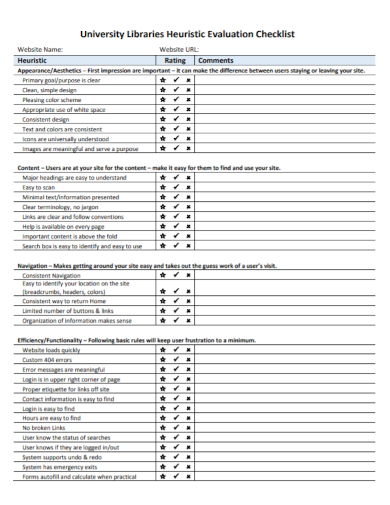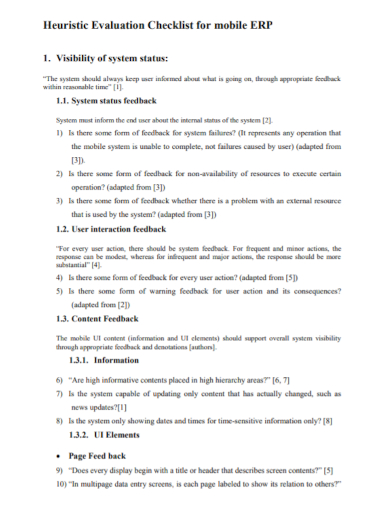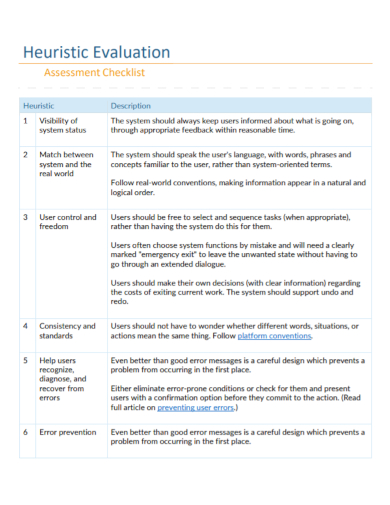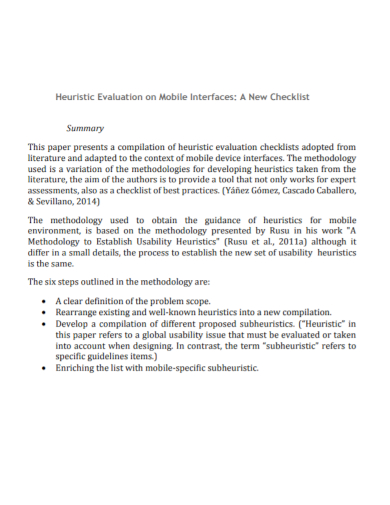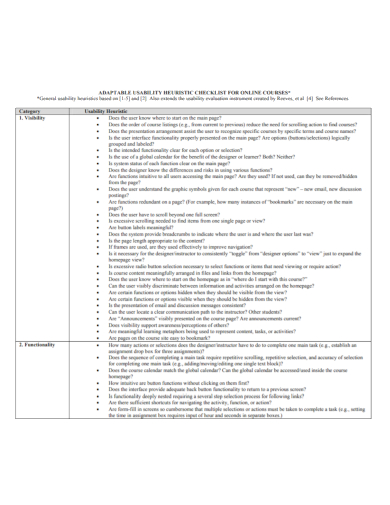A procedure in which specialists use rules of thumb to assess the usability of user interfaces in independent walkthroughs and report any flaws that they encounter is called usability testing. When evaluating products, usability experts use well-established heuristics (such as Nielsen- Molich’s) to uncover insights that can be used by design teams to improve the usability of their products from the very beginning of the development process.
You’ll learn how to perform a heuristic review on every user interface design that you come across. You will be able to build and conduct your own heuristic evaluations using the techniques described in this article, which will allow you to improve the usability, utility, and desirableness of your designs. First and foremost, take a look at the heuristic evaluation checklist samples that we have provided for you further down in this section. After getting a feel for the document, its appearance, and its functionality, you are welcome to use these samples as guides or even as templates when writing your own version of the document.
6+ Heuristic Evaluation Checklist Samples
1. University Heuristic Evaluation Checklist
2. Heuristic Evaluation System Checklist
3. Mobile ERP Heuristic Evaluation Checklist
4. Heuristic Evaluation Assessment Checklist
5. Heuristic Evaluation New Checklist
6. Usability Heuristic Evaluation Checklist
7. Adaptable Usability Heuristic Evaluation Checklist
What Is a Heuristic Evaluation Checklist?
The development of design-specific heuristics for use in evaluating products, systems, websites, and other similar endeavors is now encouraged by the design community as part of the design process. Since Nielsen and Molich developed these heuristics in the 1990s, technology has progressed, and as a result, they are less applicable to many of the items that are currently available on the market. Examples include designs intended for online communities or mobile devices where the working environment is constantly changing, making Nielsen and Molich’s heuristics inappropriate for evaluating usability. Although modern designs have unique capabilities and limitations, the original heuristics are still, to a large extent, relevant today. Consequently, it is critical that, as a designer, you become proficient in incorporating Nielsen and Molich’s design heuristics into your work as a starting point for your work. To avoid Nielsen and Molich’s heuristics becoming dominant in the process, their 10 rules of thumb should only be used to inform and inspire the development of specific heuristics by designers and companies, rather than dictating the process with Nielsen and Molich’s heuristics Market research, other design criteria, and customer needs, in conjunction with the application of your company or product-specific heuristics, will help to improve the suitability of the design under consideration.
How To Write a Heuristic Evaluation Checklist
Finding and inventing new heuristics is a difficult endeavor in and of itself; there are no firm suggestions because each design presents its own set of unique goals, restrictions, functions, styles, and other variables, and there are no definitive recommendations. There are no definitive recommendations because each design presents its own set of unique goals, restrictions, functions, styles, and other variables, and there are no definitive recommendations. The majority of heuristic evaluations, on the other hand, consist of between five and ten criteria, which are chosen based on their relevance to the overall usability of the system, website, application, or another piece of software being evaluated. Using less than five criteria may result in insufficient stringency when identifying potential problems and issues; however, using more than ten criteria may place an undue burden on the evaluator, who will have to analyze the design while keeping all of the criteria in mind; in addition, the criteria may be in conflict with one another and the heuristics may be in conflict with one another. To get started, follow the steps listed below to generate and run your own heuristic evaluation.
- Establish an appropriate list of heuristics
Inspire yourself with Nielsen and Molich’s ten heuristics, and then use Ben Shneiderman’s eight golden guidelines to help you get started on your own creative process. Always use them in conjunction with other applicable design guidelines and market research to ensure that they are effective. - Select your evaluators
Make certain that your evaluators are chosen with care and attention to detail. Users who are not evaluators should not be included in the target market. Typically, they should be usability specialists, with a preference for those who have domain expertise in the industry type in which your product is being used, as opposed to generalists. For example, a Point-of-Sale system for the restaurant industry should be evaluated by someone who at the very least has a basic understanding of the operations of a restaurant establishment. - Brief your evaluators
in order for them to be fully aware of the tasks and topics that they are expected to complete and cover throughout their evaluation period. Briefing sessions should be standardized in order to ensure that all assessors receive the same instructions; otherwise, you may find that their evaluation is influenced by the instructions they receive. It is possible to request that the evaluators concentrate on a specific set of tasks within this brief; however, they may also declare which tasks they will cover based on their previous experience and knowledge, if any, within this brief. - First evaluation phase
A product’s type and complexity determine how long it takes for the first appraisal to be completed, which takes on average about two hours. The product will be used freely by the evaluators in order for them to get a sense of the different modes of engagement and the scope of the project in general. Following that, they will select specific elements that they wish to investigate in greater depth. - Second evaluation phase
After conducting a second run-through, the evaluators will apply the heuristics that they have selected to the items that were discovered during phase one of the evaluation process. In addition to scrutinizing individual aspects, the assessors would take into account how well they fit into the overall design. - Record problems
The evaluators must either record their own problems or you should record their problems as they carry out their various tasks so that you can keep track of any problems they encounter. If the evaluators encounter problems, they must either record them themselves or you should record them as they carry out their various tasks so that you can keep track of any problems they encounter. When recording problems, it is critical to request that the assessors be as clear and thorough as possible in their documentation. - Debriefing session
To compile their findings and create a comprehensive list of issues, the debriefing session necessitates collaboration among the various assessors. They should be encouraged to come up with potential solutions to the problems they have encountered by employing the heuristics they have learned.
FAQs
What is a good heuristic evaluation?
Having a small group of evaluators examine an interface and determine whether or not it complies with widely accepted usability guidelines is referred to as heuristic evaluation.
What are the 3 types of heuristics?
- Availability
- Representativeness
- Anchoring and adjustment
How do you present heuristic findings?
A successful heuristic evaluation report should include one or more of the following elements: one or more of the following: Checklists: You can summarize the findings in your report by using a checklist or grading system (for example, a scale of 1-10) to demonstrate how closely the findings have been followed in order to demonstrate how well heuristic standards have been followed.
A successful heuristic evaluation report should include one or more of the following elements: one or more of the following: Checklists: You can summarize the findings in your report by using a checklist or grading system (for example, a scale of 1-10) to demonstrate how closely the findings have been followed in order to demonstrate how well heuristic standards have been followed.
Related Posts
FREE 14+ Sample Employee Self Evaluation Forms
FREE 12+ Observation Checklist Samples
FREE 12+ Sample Evaluation Forms
FREE 10+ IT Assessment Templates
FREE 10+ Sample Network Assessment
FREE 9+ Staff Evaluation Samples
FREE 9+ Software Evaluation Samples
FREE 9+ Sample Employee Self Evaluation
FREE 7+ Sample Project Evaluation
FREE 18+ Group Evaluation Form Samples
FREE 15+ Sample Training Evaluation Forms
FREE 13+ Equipment Checklists
FREE 13+ Management Evaluation Samples
FREE 10+ Management Audit Checklist Samples
FREE 7+ Sample Employee Evaluation

